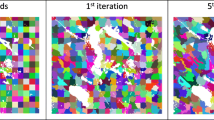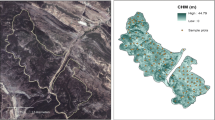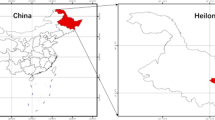Abstract
Airborne laser scanning (ALS) has been widely applied to estimate tree and forest attributes, but it can also drive the segmentation of forest areas. Clustering algorithms are the dominant technique in segmentation but spatial optimization using exact methods remains untested. This study presents a novel approach to segmentation based on mixed integer programming to create forest management units (FMUs). This investigation focuses on using raster information derived from ALS surveys. Two mainstream clustering algorithms were compared to the new MIP formula that simultaneously accounts for area and adjacency restrictions, FMUs size and homogeneity in terms of vegetation height. The optimal problem solution was found when using less than 150 cells, showing the problem formulation is solvable. The results for MIP were better than for the clustering algorithms; FMUs were more compact based on the intra-variation of canopy height and the variability in size was lower. The MIP model allows the user to strictly control the size of FMUs, which is not possible in heuristic optimization and in the clustering algorithms tested. The definition of forest management units based on remote sensing data is an important operation and our study pioneers the use of MIP ALS-based optimal segmentation.






Similar content being viewed by others
Abbreviations
- ALS:
-
Airborne laser scanning
- 3D:
-
Three dimensional
- CHM:
-
Canopy height model
- DTM:
-
Digital terrain model
- FMUs:
-
Forest management units
- GEOBIA:
-
Geospatial object- based image analysis
- GIS :
-
Geographic information systems
- LiDAR:
-
Light detection and ranging
- OF:
-
Objective function
- MIP:
-
Mixed integer programming
References
Axelsson P (2000) DEM generation from laser scanner data using adaptive TIN models. ISPRS 33:111–118
Bettinger P, Boston K (2017) Forest planning heuristics—Current recommendations and research opportunities for s-Metaheuristics. Forests 8:476.
Blaschke T (2010) Object based image analysis for remote sensing. ISPRS 65:2–16.
Chen G, Hay GJ (2011) An airborne LiDAR sampling strategy to model forest canopy height from quickbird imagery and GEOBIA. Remote Sens Enviro 115:1532–1542.
Cheng Y (1995) Mean shift mode seeking, and clustering. IEEE Pattern Anal 17:790–799.
Dubayah R, Blair JB, Goetz S, Fatoyinbo L, Hansen M, Healey S, Hofton M, Hurtt G, Kellner J, Luthcke S, Armston J, Tang H, Duncanson L, Hancock S, Jantz P, Marselis S, Patterson P, Qi W, Silva CA (2020) The Global ecosystem dynamics investigation: high-resolution laser ranging of the Earth’s forests and topography. Sci Remote Sens. https://doi.org/10.1016/j.srs.2020.100002
Duncanson L, Neuenschwander A, Hancock S, Thomas N, Fatoyinbo T, Simard M, Silva CA, Armston J, Luthcke SB, Hofton M, Kellner JR, Dubayah R (2020) Biomass estimation from simulated GEDI, ICESat-2 and NISAR across environmental gradients in Sonoma County California. Remote Sens Environ. https://doi.org/10.1016/j.rse.2020.111779
ESRI Inc. (2017) (Environmental Systems Resource Institute). Polygon neighbors command within the Analysis Tool. ESRI, Redlands, California
Gonçalves J, Pôças I, Marcos B, Mücher CA, Honrado JP (2019) SegOptim—a new R package for optimizing object-based image analyses of high-spatial resolution remotely-sensed data. Int J Appl Earth Obs 76:218–230.
Goodbody TRH, Coops NC, White JC (2019) Digital aerial photogrammetry for updating area-based forest inventories: a review of opportunities, challenges, and future directions. Curr For Rep 5:55–75.
Hay GJ, Castilla G, Wulder MA, Ruiz JR (2005) An automated object-based approach for the multiscale image segmentation of forest scenes. Int J Appl Earth Obs 7:339–359.
Heinonen T, Mäkinen A, Rasinmäki J, Pukkala T (2018) Aggregating microsegments into harvest blocks by using spatial optimization and proximity objectives. Can J For Res 48:1–10.
Hyyppä J, Hyyppä H, Leckie D, Gougeon F, Yu X, Maltamo M (2008) Review of methods of small footprint airborne laser scanning for extracting forest inventory data in Boreal Forests. Int J Remote Sens 29:1339–1366.
Jain AK (2010) Data clustering: 50 years beyond K-means. Pattern Recognit Lett 31:651–666.
Kangas A, Gobakken T, Puliti S, Hauglin M, Naesset E (2018) Value of airborne laser scanning and digital aerial photogrammetry data in forest decision making. Silva Fenn 52:9923.
Koch B, Straub C, Dees M, Wang Y, Weinacker H (2009) Airborne laser data for stand delineation and information extraction. Int J Remote Sens 30:935–963.
Liu D, Xia F (2010) Assessing object-based classification: advantages and limitations. Remote Sens Lett 1:187–194.
Lucieer A, Stein A (2005) Texture-based landform segmentation of LiDAR imagery. Int J Appl Earth Obs 6:261–270.
Maxwell AE, Warner TA, Fang F (2018) Implementation of machine-learning classification in remote sensing: an applied review. Int J Remote Sens 39:2784–2817.
Magnussen S, Næsset E, Gobakken T (2010) Reliability of LiDAR- derived predictors of forest inventory attributes: A case study with Norway spruce. Remote Sens Enviro 114:700–712.
McDill ME, Tóth SF, John RS, Braze J, Rebain SA (2016) Comparing model i and model II formulations of spatially explicit harvest scheduling models with maximum area restrictions. For Sci 62:28–37.
Michel J, Youssefi D, Grizonnet M (2015) Stable mean-shift algorithm and its application to the segmentation of arbitrarily large remote sensing images. IEEE Trans Geosci Remote Sens 53:952–964.
Mustonen J, Packalén P, Kangas A (2008) Automatic segmentation of forest stands using a canopy height model and aerial photography. Scand J For Res 23:534–545.
Næsset E, Gobakken T, Holmgren J, Hyyppä H, Hyyppä J, Maltamo M, Nilsson M, Olsson H, Persson A, Söderman U (2004) Laser scanning of forest resources: the Nordic experience. Scand J For Res 19:482–499.
Öhman K, Eriksson LO (2010) Aggregating harvest activities in long term forest planning by minimizing harvest area perimeters. Silva Fenn 44:77–89
Ordway EM, Asner GP (2020) Carbon declines along tropical forest edges correspond to heterogeneous effects on canopy structure and function. PNAS 117:7863–7870.
Olofsson K, Holmgren J (2014) Forest stand delineation from lidar point-clouds using local maxima of the crown height model and region merging of the corresponding Voronoi cells. Remote Sens Lett 50:268–276
Packalen P, Pukkala T, Pascual A (2020) Combining spatial and economic criteria in tree-level harvest planning. For Ecosyst 7:18.
Pascual A (2018) Improving forest management planning by means of airborne laser scanning and dynamic treatment units based on spatial optimization. Dissertationes Forestales 257:60.
Pascual A, Pukkala T, de Miguel S, Pesonen A, Packalen P (2019) Influence of size and shape of forest inventory units on the layout of harvest blocks in numerical forest planning. Eur J For Res 138:111–123.
Pukkala T (2019) Optimized cellular automaton for stand delineation. J For Res 30:107–119.
Pukkala T (2019) Using ALS raster data in forest planning. J For Res 30:1581–1593.
Pukkala T (2020) Delineating forest stands from grid data. Forest Ecosyst. 7:105
Räsänen A, Rusanen A, Kuitunen M, Lensu A (2013) What makes segmentation good? a case study in boreal forest habitat mapping. Int J Remote Sens 34:8603–8627.
Rönnqvist M, D’Amours S, Weintraub A, Jofre A, Gunn E, Haight RG (2015) Operations research challenges in forestry: 33 open problems. Ann Oper Res 232:11–40.
Saǧlam B, Salman FS, Sayin S, Türkay M (2006) A mixed-integer programming approach to the clustering problem with an application in customer segmentation. Eur J Oper Res 173:866–879.
San-Miguel I, Coops NC, Chavardès RD, Andison DW, Pickell PD (2020) What controls fire spatial patterns? Predictability of fire characteristics in the Canadian boreal plains ecozone. Ecosphere 11:e02985.
Saremi H, Kumar L, Stone C, Melville G, Turner R (2014) Sub-compartment variation in tree height, stem diameter and stocking in a Pinus radiata D Don plantation examined using airborne LiDAR data. Remote Sens 6:7592–7609.
Stereńczak K, Lisańczuk M, Erfanifard Y (2018) Delineation of homogeneous forest patches using combination of field measurements and LiDAR point clouds as a reliable reference for evaluation of low resolution global satellite data. For Ecosys 5:1–12.
Wehr A, Lohr U (1999) Airborne laser scanning — An introduction and overview. ISPRS J Photogramm 54:68–82.
White JC, Coops NC, Wulder MA, Vastaranta M, Hilker T, Tompalski P (2016) Remote sensing technologies for enhancing forest inventories: a Review. Can J Remote Sens 00:1–23.
Wulder MA, White JC, Nelson RF, Næsset E, Ørka HO, Coops NC, Hilker T, Bater CW, Gobakken T (2012) Lidar sampling for large-area forest characterization: a review. Remote Sens Enviro 121:196–209.
Acknowledgements
The authors thank the University of Eastern Finland and the University of Washington for financial, technical, and scientific support during the first stages of the research. The study also benefited from the research exchange platform provided by the SuFoRun project (Marie Sklodowska-Curie Grant Agreement No. 691149). The first author (I.P. in the scope of Norma Transitória –DL57/2016/CP5151903067/CT4151900586) was supported by Fundação para a Ciência e a Tecnologia through the MODFIRE project—A multiple criteria approach to integrate wildfire behavior in forest management planning (PCIF/MOS/0217/2017).
Author information
Authors and Affiliations
Corresponding author
Additional information
Publisher's Note
Springer Nature remains neutral with regard to jurisdictional claims in published maps and institutional affiliations.
Project funding: This study was supported by MODFIRE project—A multiple criteria approach to integrate wildfire behavior in forest management planning (PCIF/MOS/0217/2017), and benefited from the research exchange platform provided by the SuFoRun project (Marie Sklodowska-Curie Grant Agreement No. 691149).
The online version is available at http://www.springerlink.com.
Corresponding editor: Yu Lei.
Rights and permissions
About this article
Cite this article
Pascual, A., Tóth, S.F. Using mixed integer programming and airborne laser scanning to generate forest management units. J. For. Res. 33, 217–226 (2022). https://doi.org/10.1007/s11676-021-01348-2
Received:
Accepted:
Published:
Issue Date:
DOI: https://doi.org/10.1007/s11676-021-01348-2




